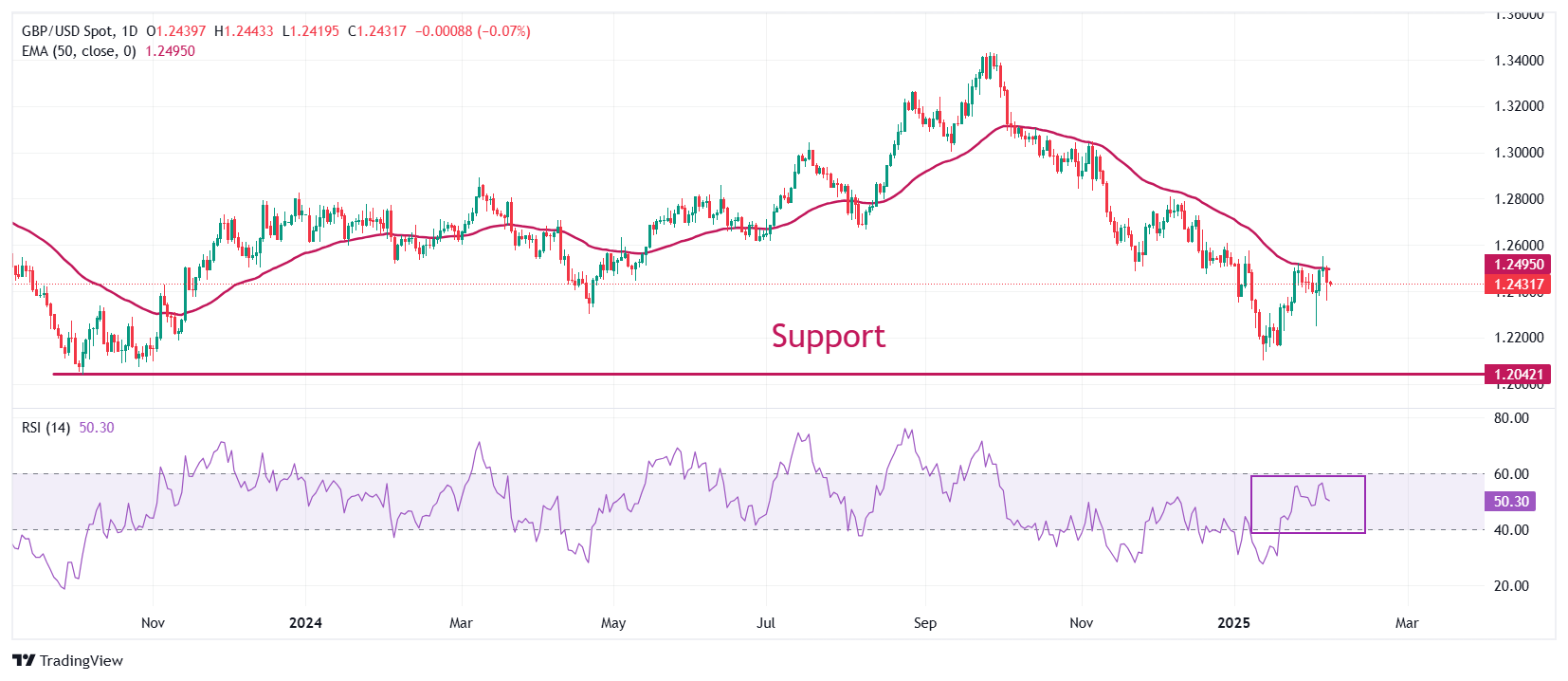Pound Sterling flattens against USD ahead of US NFP
- The Pound Sterling edges lower to near 1.2420 against the USD ahead of the US NFP data for January.
- Investors expect the US NFP to drive market expectations for the Fed’s monetary policy outlook.
- BoE’s Catherine Mann surprisingly supported a bigger interest rate reduction of 50 bps.
The Pound Sterling (GBP) ticks lower to near 1.2420 against the US Dollar (USD) in Friday’s European session ahead of the United States (US) Nonfarm Payrolls (NFP) data for January, which will be published at 13:30 GMT. The US Dollar Index (DXY), which tracks the Greenback’s value against six major currencies, ticks higher to near 107.80
Investors will pay close attention to the US official employment data, which is expected to influence market speculation about how long the Federal Reserve (Fed) will keep interest rates steady in the range of 4.25%-4.50%.
On Thursday, Dallas Fed Bank President Lorie Logan said she would support holding interest rates for “quite some time” until the “labor market doesn’t falter” even if inflationary pressures decelerate closer to the central bank’s target of 2%.
Last week, Fed Chair Jerome Powell also said that monetary policy adjustments won’t be appropriate until the central bank sees “real progress in inflation or at least some weakness in labor market”.
The US NFP report is expected to show that the economy added 170K workers in January, significantly lower than 256K in December. The Unemployment Rate is seen steady at 4.1%. Investors will also focus on the Average Hourly Earnings data, a key measure of wage growth that drives consumer spending. The wage growth measure is estimated to have decelerated to 3.8% year-on-year from 3.9% in December, with monthly figures growing steadily by 0.3%.
Meanwhile, the uncertainty over US President Donald Trump’s tariff agenda will also keep investors on their toes. Market participants expect President Trump to target Europe next for imposing tariffs.
Daily digest market movers: Pound Sterling trades with caution as BoE halves GDP forecasts
- The Pound Sterling trades cautiously against its major peers on Friday after a sharp sell-off on Thursday. Investors dumped the British currency the prior day after the Bank of England’s (BoE) policy meeting, in which the central bank reduced interest rates by 25 basis points (bps) to 4.5% and revised Gross Domestic Product (GDP) forecast for the year to 0.75%, lower from 1.5% projected in November.
- Investors had anticipated a 25 bps interest rate reduction, with an 8-1 vote split, but all officials supported easing the monetary policy further. However, the notable reason behind the sharp sell-off in the Pound Sterling was Monetary Policy Committee (MPC) member Catherine Mann, an outspoken hawk, joining official Swati Dhingra and favoring a bigger rate cut of 50 bps. This scenario indicated how much policymakers are concerned over the economic outlook.
- BoE Governor Andrew Bailey guided a cautious and gradual rate cut approach and warned that, due to higher energy prices, inflation could temporarily rise to near 3.7% in the third quarter of the year before falling back to the 2% path.
- BoE’s interest rate cut decision is expected to bring a big relief to the United Kingdom (UK) Chancellor of the Exchequer Rache Reeves, as it will stimulate economic growth. Still, downwardly revised GDP growth appears to be a wake-up call for her. Last week, Reeves was very optimistic about her economic plans, including a new runway at Heathrow Airport.
Technical Analysis: Pound Sterling trades inside Thursday’s trading range

The Pound Sterling oscillates inside Thursday’s trading range against the US Dollar on Friday. The outlook of the GBP/USD pair remains weak as the 50-day Exponential Moving Average (EMA) continues to act as a resistance at around 1.2500.
The 14-day Relative Strength Index (RSI) oscillates inside the 40.00-60.00 range, suggesting a sideways trend.
Looking down, the January 13 low of 1.2100 and the October 2023 low of 1.2050 will be key support zones for the pair. On the upside, the December 30 high of 1.2607 will act as key resistance.
Pound Sterling FAQs
The Pound Sterling (GBP) is the oldest currency in the world (886 AD) and the official currency of the United Kingdom. It is the fourth most traded unit for foreign exchange (FX) in the world, accounting for 12% of all transactions, averaging $630 billion a day, according to 2022 data. Its key trading pairs are GBP/USD, also known as ‘Cable’, which accounts for 11% of FX, GBP/JPY, or the ‘Dragon’ as it is known by traders (3%), and EUR/GBP (2%). The Pound Sterling is issued by the Bank of England (BoE).
The single most important factor influencing the value of the Pound Sterling is monetary policy decided by the Bank of England. The BoE bases its decisions on whether it has achieved its primary goal of “price stability” – a steady inflation rate of around 2%. Its primary tool for achieving this is the adjustment of interest rates. When inflation is too high, the BoE will try to rein it in by raising interest rates, making it more expensive for people and businesses to access credit. This is generally positive for GBP, as higher interest rates make the UK a more attractive place for global investors to park their money. When inflation falls too low it is a sign economic growth is slowing. In this scenario, the BoE will consider lowering interest rates to cheapen credit so businesses will borrow more to invest in growth-generating projects.
Data releases gauge the health of the economy and can impact the value of the Pound Sterling. Indicators such as GDP, Manufacturing and Services PMIs, and employment can all influence the direction of the GBP. A strong economy is good for Sterling. Not only does it attract more foreign investment but it may encourage the BoE to put up interest rates, which will directly strengthen GBP. Otherwise, if economic data is weak, the Pound Sterling is likely to fall.
Another significant data release for the Pound Sterling is the Trade Balance. This indicator measures the difference between what a country earns from its exports and what it spends on imports over a given period. If a country produces highly sought-after exports, its currency will benefit purely from the extra demand created from foreign buyers seeking to purchase these goods. Therefore, a positive net Trade Balance strengthens a currency and vice versa for a negative balance.

